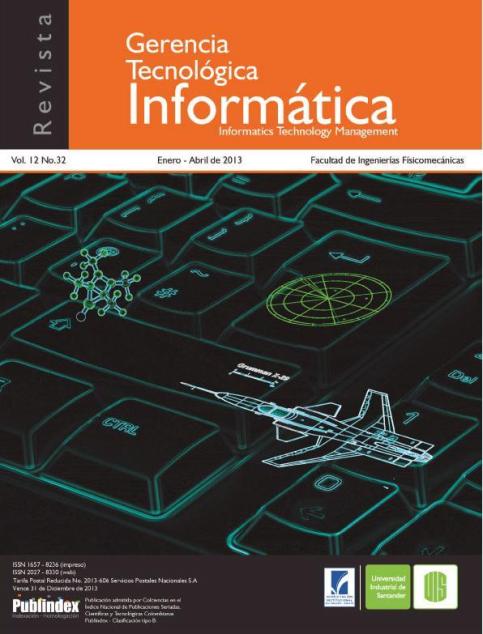Publicado 2013-05-24
Cómo citar
Resumen
RESUMEN ANALÍTICO
El presente artículo presenta un procedimiento para obtener experimentalmente modelos matemáticos que describan el comportamiento de las dinámicas de elevación (pitch) y alabeo (roll) en un avión a escala (aeromodelo UAV). Para ello se constituye un sistema inalámbrico de captura de datos en línea sobre un prototipo de pruebas. Una vez configuradas las diferentes etapas del proceso de identificación se procede a la realización del análisis estadístico de los datos de un aeromodelo en vuelo. Los resultados obtenidos para la relación entrada-salida (modelos del sistema) se consideran satisfactorios a partir de validación por contraste entre datos reales y predicciones teóricas. La manipulación del comportamiento dinámico del avión a escala, a partir de técnicas de control diseñadas con base en los modelos generados, son parte de actividades complementarias actualmente en desarrollo.
PALAbRAS CLAVES: Aeromodelo UAV, Dinámicas de elevación (pitch) y alabeo (roll), Identificación de modelos, Instrumentación inalámbrica
ANALYTICAL SUMMARY
This project is aimed at performing experimental identification for dynamics of the Pitch and Roll axes in an UAV. First of all, a set of wireless measurement devices is installed in a test prototype. After setting all parameters on a practical methodology for acquirement and treatment of data, analysis of information taken from a real flying device has been performed. As main result we underline the accuracy shown between theoretical predictions (numerical models) and experimental measurements relating the angular position for the Pitch and Roll axes. This information will be then used to manipulate dynamics of the UAV by mean of control techniques as part of current ongoing work.
KEYWORDS: UAV – Unmanned Aerial Vehicle, Pitch and Roll axes dynamics, Experimental identification, Wireless measurement devices
Descargas
Referencias
- HAMMER, A. y otros. Deblurring of UAV aerial images for civil structures inspections using Mumford-Shah / Total variation regularisation. En: International Symposium on Image and Signal Processing and Analysis – ISPA (5th: 2007: Estambul).
- MONTAMBAULT, J. y otros. On the application of VTOL UAVs to the inspection of power utility assets. En: International Conference on Applied Robotics for the Power Industry – CARPI (1st: 2010: Montreal).
- GADEMER, A. y otros. Solutions for near real time cartography from a mini-quadrotor UAV. En: Remote Sensing for Environmental Monitoring, GIS Applications, and Geology - SPIE 7478 (IX: Berlin: 2009).
- WANG, Y. y otros. Meteorological UAV Pitot-static tube wind error source and sensitivity analysis. En: International Conference on Remote Sensing, Environment and Transportation Engineering – RSETE (2011: China).
- POLLANEN, R. y otros. Radiation surveillance using an unmanned aerial vehicle. Applied Radiation and Isotopes. Vol. 67. No. 2. pp 340-344. Elsevier, 2009.
- YE, Z. y otros. Equational dynamic modeling and adaptive control of UAV. En: International Conference on System of Systems Engineering - IEEE/SMC (Los Angeles: 2006).
- MORAR, I. y NASCU, I. Model simplification of an unmanned aerial vehicle. En: IEEE International Conference on Automation Quality and Testing Robotics – AQTR (Rumania: 2012).
- MENG, L. y otros. Aerodynamic parameter estimation of an Unmanned Aerial Vehicle based on extended Kalman filter and its higher order approach. En: International Conference on Advanced Computer Control – ICACC (2nd: China: 2010).
- KALLAPUR, A. y ANAVATTI, S. UAV Linear and Nonlinear Estimation Using Extended Kalman Filter. En: International Conference on Computational Intelligence for Modelling, Control and Automation (Sydney: 2006).
- KHALIL, B. y YESILDIREK, A. System identification of UAV under an autopilot trajectory using ARX and Hammerstein-Wiener methods. En: International Symposium on Mechatronics and its Applications – ISMA (7th: Emiratos Árabes: 2010).
- NONG, Y. y otros. System identification of a small unmanned aerial vehicle based on time and frequency domain technologies. En: World Congress on Intelligent Control and Automation – WCICA (9th: Taipei: 2011).
- YAO, J. y otros. Study on UAV flight based identification technology. En: Chinese Control Conference (29th: Beijing: 2010).
- KAMEN, Edward y SU, Jonathan. Introduction to optimal estimation. Londres: Springer-Verlag, 1999. 394 p.
- VERA ROZO, Edwin. Validación experimental del modelo de dos ejes de un avión a escala. Bucaramanga, 2012, 86 p. Trabajo de grado (Ingeniero Electrónico). Universidad Industrial de Santander. Facultad de Ingenierías FísicoMecánicas.
- LJUNG, Lennart. System Identification Toolbox: for use with MATLAB. User´s Guide. Massachussets: The MathWorks Incorporated, 1997. 274 p.
- LJUNG, Lennart. System Identification: Theory for the user. 2 ed. New Jersey: Prentice Hall, 1999. 672 p.
